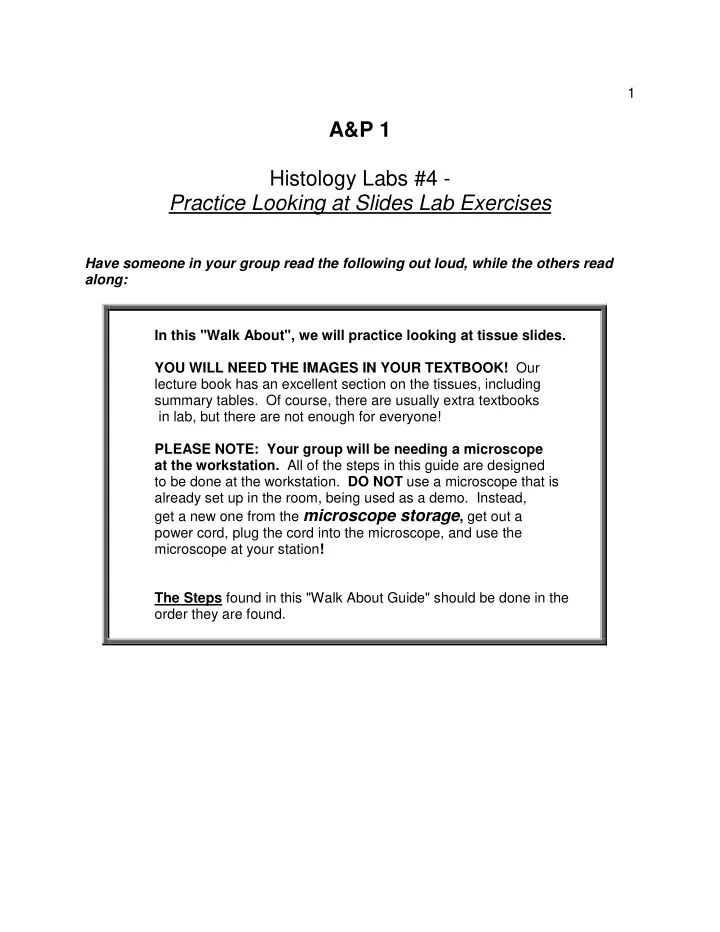

1 A&P 1 Histology Labs #4 - Practice Looking at Slides Lab Exercises Have someone in your group read the following out loud, while the others read along: In this "Walk About", we will practice looking at tissue slides. YOU WILL NEED THE IMAGES IN YOUR TEXTBOOK! Our lecture book has an excellent section on the tissues, including summary tables. Of course, there are usually extra textbooks in lab, but there are not enough for everyone! PLEASE NOTE: Your group will be needing a microscope at the workstation. All of the steps in this guide are designed to be done at the workstation. DO NOT use a microscope that is already set up in the room, being used as a demo. Instead, get a new one from the microscope storage , get out a power cord, plug the cord into the microscope, and use the microscope at your station ! The Steps found in this "Walk About Guide" should be done in the order they are found.
2 Step 1. Study Tips Before Moving On, and some practice! Have someone in your group read the following out loud, while the others #1 read along: Opening Paragraph (we'll be referring to this later) Now, we are going to go through some of the more common Epithelial Tissue types seen in lab. Each tissue type can look different, under different circumstances. In order to help you get ready for the exam: 1. Realize that every slide has more than 1 tissue on it. The student must identify what the instructor is referring to BEFORE answering. 2. Make sure you look for something to orient yourself. If you can see the lumen, that is a good place to start! Also, think about "superficial" and "deep". 3. Draw what you see. Note which power you are at. 4. Concentrate on how slides of the same tissue look SIMILAR, instead of focusing on the differences. In order to help you with this, this guide is going to ask you for a short phrase "descriptor" for each. What is meant by that? WRITE DOWN what first pops into your head, because the next time you see it, the same phrase will pop into your head. Do the practice exercise seen on the next couple of pages.
3 Let's get a little practice on a photo before we jump to slides. Let's pretend that #2 we are studying "simple columnar epithelium", and we are told to get out this slide: And the guide tells us to study this tissue #3 First, let's ID it. Using an image in the book, we decide....... Q1. Label the lumen on the above image. Notice that there is another tissue just deep to the tissue we want to ID. Indicate, using an arrow, "superficial" to "deep" on the above image.
4 Q2. Write what the tissue does in a general sense (be aware of your instructor's examples): Q3. Give some examples of where you might find the tissue. You do not have to name every place in the body; just be aware of your instructor's examples. Q4. Name any special cells that you associate with the tissue, or other special characteristic (be aware of your instructor's examples). If the answer is "none", write that! Q5. Then let's draw it and label it in this box Indicate the following on your drawing: Lumen Columnar cell with nucleus Apical surface (draw a line over it....more or less) Basement Membrane (draw a line over it....more or less) Goblet cell "Other tissues" in view, even if you can't ID them Q6. Note the power:
5 Now, try to think of something that it reminds you of from your day-to-day #4 life. But do this just the tissue you are studying (simple columnar)...do not include the other cells on the slide! Do not just write down what your study partner thinks....you have to come up with your own! Don't force it...just keep looking until something pops in your head. I'll help on this one. How about....books on a book shelf? Simple columnar Books on a shelf Descriptor Term: books on a shelf Don't like that descriptor term? Then get your own!
Recommend
More recommend